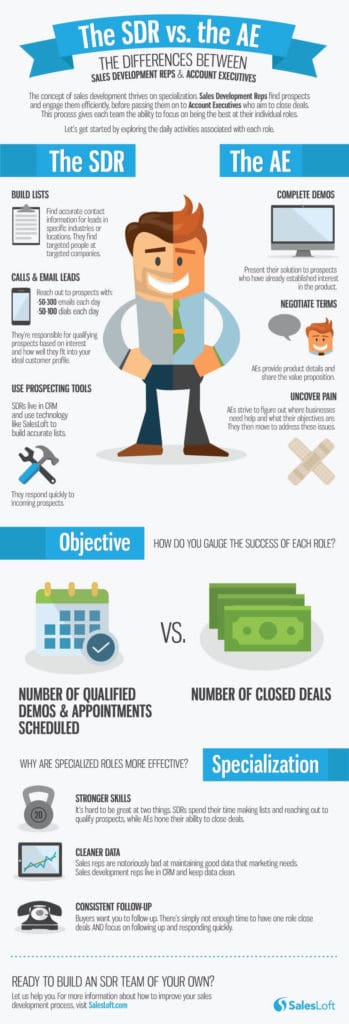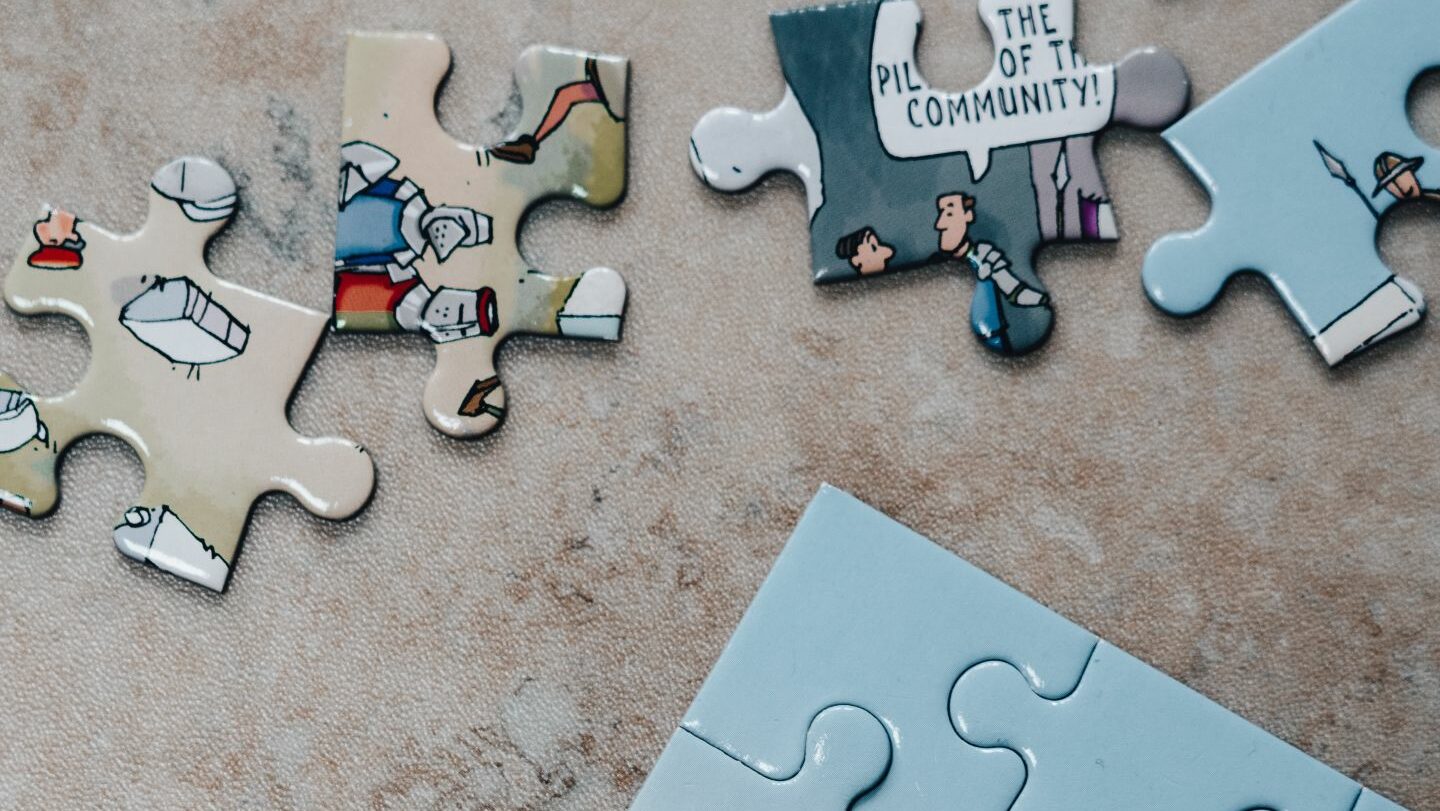David Cumming describes SDRs (Sales Development Representatives) as the most important innovation in the world of sales in the last 10 years. Looking to strengthen your sales team by building a team of SDRs?
In this article, we offer you a well-founded definition of this new profession, the essential skills needed to succeed (or succeed in your recruitment), and some advice to help you take your sales prospecting to the next level.
Sommaire
Definition of the SDR position (also called BDR)
The definition of the SDR (Sales Development Representative) is problematic because it depends very much on the sales processes observed, and therefore ultimately on the organisation. Some will tell you that SDRs only do pure prospecting, others will tell you that they are responsible for qualifying leads sent by marketing…
The constant, it seems, is rather the “output” expected from an SDR. SDRs are not (or very rarely) intended to generate income directly. In the vast majority of organisations (and the definitions we have found), the SDR provides qualified appointments to another sales person (usually called an Account Executive), who is responsible for bringing the sale to completion.
A definition of the role of SDR: lead distribution
For many years the sales industry has been stagnant. Different types of sales tools have appeared but without fundamentally changing the approach. The traditional pattern of salespeople calling prospects, bordering on harassment, in the hope of making a sale is a bit of a cliché, but has endured. The trouble is that this strategy is very unproductive in terms of revenue generation. It takes an average of 60 to 90 phone calls to get an appointment with a prospect, making sales miserably difficult.
The SDR allocates calls to the right people for quick and effective action. His role is to understand the customer’s or prospect’s problem, to qualify it in terms of potential and sector of activity, then to forward the lead to the Account Executive (AE) who has all the keys to answer the questions.
Here’s why, according to David Cummings, the creation of the SDR role is the most important innovation in the world of sales over the last 10 years:
- Making contact with prospects takes time and resources
- A fast and standardised lead follow-up process is the key to conversion
- Converting a lead into an opportunity requires training as such
- Marketing and contact data have improved considerably with the development of sales
- Alignment of sales and marketing is a must today
- Your buyer wants you to follow up on the sale
The emergence of the SDR role can be seen as a kind of division of labour in the sales world. In any case, it coincides with a better distribution of the workload within the sales teams. The idea is to split up the sales funnel: SDRs process leads to generate “opportunities” (for those familiar with salesforce software). This allows downstream salespeople to deal only with truly qualified opportunities.
SDRs and outbound sales: towards a redefined role?
In some sales organisations (particularly in B2B, on medium and high ticket sizes), as the SDRs are relatively close to the role of marketing in the sales cycle, they have taken over all lead generation processes.
It is this shift in responsibility from marketing to SDRs that is behind “ABM” (Account Based Marketing).(Account Based Marketing): the SDRs are the ones who identify the right contacts within the few key accounts and seek appointments.

Source : Salesloft
SDR tasks & tools
The development of the role of the SDR within organisations has led to the development of numerous prospecting tools. These tools are adapted to the different lead acquisition channels and allow the optimisation of processes that the SDR cannot focus on. Do you know which channel you want to develop but find it difficult to make the right choice among the many tools?
We’ve compiled here a list of tools specifically adapted to SDRs:
- The complete list of SDR tools
- The best cold email tools
- The best chrome extensions to boost your sales
#1 The hunt for contacts
Depending on the sales organisation, SDRs are either ‘fed’ directly by marketing, or they are equipped to do their own hunting. When they have to go out and find leads themselves, the SDRs havelead generation tools such as Sales Navigator,Societeinfo, orNomination. These tools are powerful and allow the SDR to strengthen its knowledge of the customer or prospect.
#2 Social selling
The use of networks such as Twitter, LinkedIn and (to a lesser extent) Facebook is essential in B2B, especially in the technology and software sectors.
SDRs use this tool to pass on their knowledge, to establish themselves as experts in the proposed solution and to provide their expertise in the field or sector of activity of your prospects. This expertise translates into the publication of targeted content, which can take the following forms:
- White papers or ebooks
- Case studies or success stories on how your solution provided a decisive answer for your customer.
- Webinars where you bring in experts on the subject, from within or outside your organisation.
The main thing is not to provide information in quantity but in quality and especially adapted to your audience!
Our advice
Make sure that the SDRs also talk a little about themselves. Don’t make it personal, but showing your personality humanises the process.
Another way in which SDRs can use social networks is to unearth information that could help qualify prospects. Through tools and different profiles of each person, sales representatives can find out information about the contact and get information that will be useful in the further sales process.
Social networks, mainly LinkedIn, are perfect for introducing yourself and making yourself known. Searching for leads through a search or using software will usually lead you to a prospect’s profile. Adding them to your network and starting a conversation is a popular but still effective method of introduction.
#3 Email Prospecting
Sending cold emails is an essential function of the SDR role. For effective lead qualification, email campaign management and cold calling must be coordinated. Sending impactful emails that get responses is not an easy thing to do, so you need to make sure your SDRs are good at this aspect of the job. Copywriting should be a skill that is constantly being learned and improved.
Email responses help to find decision makers, educate potential buyers and move prospects through the sales funnel.
Here are some tips to keep in mind for your sales development officers:
- This is not copywriting
The title should be punchy and engaging, but the body of the message should read like an email. If your sales people start sending a long sales form by email, it will be seen as spam, even if it is good.
Personalisation is an essential dimension of your email prospecting. Beforehand, it is important to segment your mailing list using the information collected during lead qualification or usingdata enrichment solutions.
- Remember the influencers
Don’t just target the decision maker. Talking to direct and indirect influencers helps good SDRs to find their way into meetings and discussions between procurement teams.
If more than one person regularly communicates with a CSD, they are likely to become a prime prospect.
- Understanding the details
As sales people write personal emails and fill the sequential content pipeline, a prospect may receive an email that was not intended for them. Customers may continue to receive sales emails, resources may be sent twice, etc. To ensure optimal follow-up of these different actions, you need to choose the right CRM and ensure that the processes are well integrated by the whole sales team.
Feel free to use the following resources to strengthen your email marketing
- Best practices to improve your B2B prospecting emails
- 8 facts about email marketing
- How to email a prospect who no longer responds
#4 cold calling
The telephone is often the most revealing part of an SDR’s work.
The primary responsibility of this sales role is to qualify prospects. This work involves finding and populating target account data, nurturing inbound leads and identifying high and low potential prospects.
One of the quickest ways to qualify a lead is to have a real conversation with the decision makers about their current solution and needs.
If you can get the right person on the phone and ask the right questions, you can quickly ask them to close or stop the sales process. That’s why SDRs are tracked and compensated based on the number of Sales Qualified Appointments (SQAs) they are able to obtain.
If you have a detailed marketing funnel and an effective lead scoring system, SDRs should be the link between marketing and deal makers.
Feel free to use the following resources to improve your cold calling
- 20 tips for getting really good at cold calling
- Find 7 examples of telephone sales scripts
- Discover 10 questions to qualify a prospect by phone
What makes a good SDR?
Let’s face it, while SDRs play an absolutely fundamental role in the commercial success of companies, it is still a junior role in the vast majority of cases. Therefore, recruiting these key people is a critical dimension to the success of the SDR / AE strategy.
Motivation
You cannot be a successful CSD if you are not competitive. Your candidate will do the hardest work in sales. There are a few personal histories that generally indicate high sales potential:
- Did they play sports? University students or former professional athletes are often good candidates for sales development.
- Have they been in the army or the police? People in these roles succeed in environments that are hazardous to their health. Picking up the phone to make cold calls won’t seem so scary after that!
- Do they come from a competitive sector (e.g. finance, consulting, law)? People who have had high pressure careers are often good candidates for sales.
Being a CSD can be exhausting. On a daily basis, you are faced with constant rejection. To succeed, your candidate must be passionate about the product and the sale itself. Without this, he or she will fail when the going gets tough. To check this, ask the candidate what they know about the product and why they want to sell it. If they are unsure, or don’t have a satisfactory answer, move on.
The work ethic
Failure is a common phenomenon for SDRs. It is the way they deal with failure that makes their character. Ask your candidates to tell you about a time when they failed and what they did because of it. The best candidates will be honest and have a good story to tell.
While the role of SDRs is important, it is not a high-level role. It means that you will be recruiting people with raw talent, but whose skills need to be honed. It means they need to be able to accept and act on feedback. A good way to check this in the recruitment process is to give them constructive feedback. Tell the candidate that the point you told them to focus on is important for the next interview. Then see if they have changed their behaviour for that interview.
Creativity
Modern SDRs need to be creative. It is not enough to blindly follow a process: the modern business landscape has changed dramatically in the last 15 years. In the early 2000s, it was enough to send thousands of emails to ask for a recommendation. Today, we live in a world of hyper-personalisation and educated buyers. The best SDRs must be able to adapt to the changing environment and think for themselves.
Efficiency
Successful SDRs find to automate prospecting and operate as if they can manipulate time. According to Marketo, SDRs can complete about 40 to 60 tasks per day, about three quarters of which are lead nurturing of inbound prospects.
By responding and connecting with prospects as quickly as possible, they set themselves up for success: According to Datanyze, when a salesperson responds to a prospect within one minute, he or she increases their conversion rate by 156%.
The rest of the SDRs’ time should be spent translating the data collected into the various tools that exist for this purpose. The more information the organisation has about a prospect, the more likely it is to be able to offer a suitable solution.
We hope that this detailed guide will help you to build a strong team of SDRs and thus form a sales team more suited to the current environment. Please feel free to share your experience in the comments if the role of SDR is already well established in your company!





